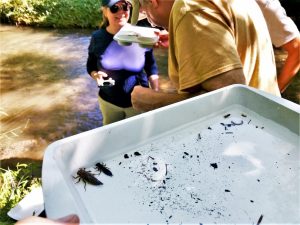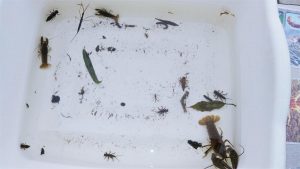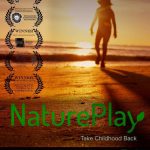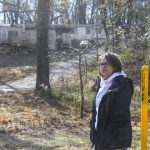
Dr. David Osgood arrived in Reading at a serendipitous time: within his first month of teaching Biology at Albright College, Tropical Storm Allison poured down on Reading, causing the Angelica Creek Dam to breach and exposing the previously submerged floodplain to the open air for the first time in nearly 100 years.
For Dr. Osgood, a wetland specialist with expertise in floodplain maturation and restoration, the recently drained lakebed was the perfect floodplain template – a clean slate. Furthermore, the City of Reading, which owned the property, planned to restore the wetland habitat rather than replace the dam and refill the lakebed with water.
The scene was set to watch a fledgling floodplain take flight.
Dr. Osgood wanted to track changes in Angelica Creek’s health over time and in response to the City’s restoration efforts. In theory, the prescribed floodplain restoration should improve the water quality of the once submerged creek, and Dr. Osgood hoped to see this recovery play out in real life.
A project of this temporal scale required a long-term indicator of stream health. For Dr. Osgood, all roads led to one obvious choice: bugs (officially referred to as aquatic macroinvertebrates by the scientific community).
You may be wondering, what can a “bug” tell you about stream health?
Quite a lot if, like Dr. Osgood, you’re willing to listen.
Our local waterways are filled with these aquatic macroinvertebrates, animals that make their living underwater and are visible to the naked eye but have no backbone. Here they live, day-in and day-out, tucked among leaves and woody debris and clinging to rocks and roots.
Many macroinvertebrates are insect larvae and will ultimately mature into a winged adult form – dragonflies, damselflies, and mayflies to name a few – taking flight after living underwater for one to even five years! But during the waterlogged chapter of their lives, macroinvertebrates aren’t very mobile and tend to stay close to home until it’s time to fly the coop.
Additionally, aquatic macroinvertebrates vary in their sensitivities to stressors like high temperatures, reduced levels of dissolved oxygen, and elevated salt concentrations. For example, black fly larvae are very tolerant and can live under even the most brutal conditions. But young mayflies and stoneflies are much more sensitive and can only thrive when water is cold and dissolved oxygen is abundant.
It’s this collection of characteristics – variable pollution tolerance and a long-lived, submerged residency – that make macroinvertebrates such valuable indicators of stream health.
Put another way: who you find living in a stream can reveal a lot about the water’s physical condition and health. A diverse and abundant community of sensitive, pollution-intolerant macroinvertebrates suggests that the water has successfully satisfied and maintained the rigorous criteria of these persnickety animals, not just for one day, but for months even years!
It’s for these reasons that macroinvertebrates stand front and center in Dr. Osgood’s study of Angelica Creek and the systemic changes following floodplain restoration efforts.
“If we were going to see changes that meant the development in the system was sticking, it would show up in the macroinvertebrates,” explained Dr. Osgood – when it comes to long-term indicators of stream health, bugs are best.
Dr. Osgood and his students set out to monitor the macroinvertebrate community at both the restoration site in Angelica Creek Park, but also at a reference site upstream of the floodplain restoration, in Nolde Forest State Park where an exceptionally healthy portion of Angelica Creek flows.
These two macroinvertebrate communities were evaluated in terms of their diversity (how many macroinvertebrate families are present?), their dominance (how abundant is each family and is this spread of abundance balanced?), and their Family Biotic Index (based on the pollution tolerance of each family present, how healthy is the creek?).
Macroinvertebrate monitoring began in 2005, continued through the floodplain’s restoration between 2008 and 2009, and is on-going today accumulating nearly 15 years of data. During that time, Angelica Creek’s former lakebed has undergone an incredible transformation.
Early on, the restoration site’s macroinvertebrates shared little resemblance with Nolde Forest’s reference community: most notably, the restoration site’s Family Biotic Index score was significantly poorer compared to the reference site. The pollution-sensitive macroinvertebrates found at Nolde Forest were mostly absent at the Angelica Creek Park.
That started to change in 2015, six years after the floodplain restoration was completed. Since 2015, the restoration site at Angelica Creek Park has consistently earned Family Biotic Index scores that are comparable to Nolde Forest’s macroinvertebrate community! The creek flowing through the restored floodplain can now support macroinvertebrates that require clean, cool, and healthy water.
It is important to note that macroinvertebrates provide one perspective on stream health, and although this is a compelling view it is not, nor should it be, the only lens through which we observe Angelica Creek’s recovery. Working in tangent with the macroinvertebrates, Dr. Osgood and a few particularly ambitious students also collected data on Angelica Creek’s hydrology and floodplain plant community. These are all complementary datasets that help bring into focus the clearest image of Angelica Creek’s health.
Angelica Creek’s macroinvertebrates remind us that recovery takes time; the water quality benefits of Angelica Park’s floodplain restoration didn’t manifest in the wildlife living there until six years after the fact. Remember, the Angelica Creek dam was first erected in the mid-1880s, interfering with the natural flow and processes of the creek for 125 years; recovery from such a prolonged intervention won’t happen overnight.
But If we’re willing to listen, the bugs have a lot to say along the way.

The State of the Environment evaluates specific data and trends in five environmental categories: Air, Energy, Land, Waste, and Water. Within each category, several specific quantitative indicators are evaluated using available data, trends in the data are assessed, and specific action items that residents can practice to make each specific indicator more “positive” are identified. The five general environmental categories, as well as the specific environmental indicators evaluated, were selected by an interactive process. Berks Nature established subcommittees for each category, with each subcommittee headed by a professional with substantial experience in the specific field. These subcommittees discussed candidate indicators, and narrowed down the list of indicators to be used to 4-5 specific indicators where quantitative data were available.
While we could have selected many indicators regarding the health of the environment, our panel of experts chose the 25 contained in this report as a start. We pursued measurable, actionable data that would allow individuals, corporations and organizations to see where they could make lifestyle changes that would have increasingly positive effects on our local environment, the state, the country and the world. We used a third party consultant to research and write up the indicators and data. While we have tried to be as neutral as possible, obviously Berks Nature has a bias toward environmental conservation and protection. Rest assured, the data contained in this report is accurate and the facts will ultimately speak for themselves. We hope you learn something new, consider changing some of your behaviors as a result, and we invite you to become engaged in our work and that of other conservation and environmental organizations; the health of our community depends on it.




